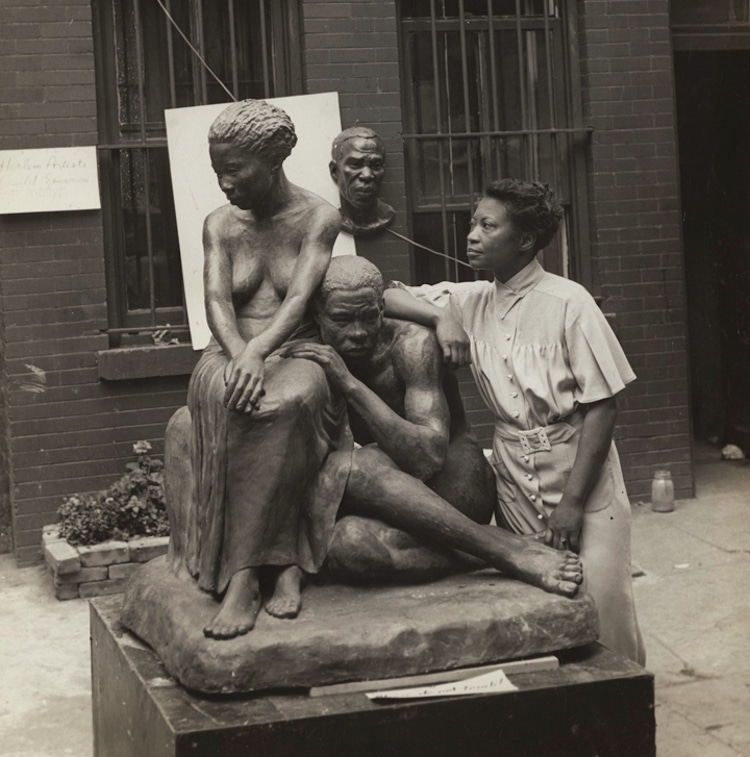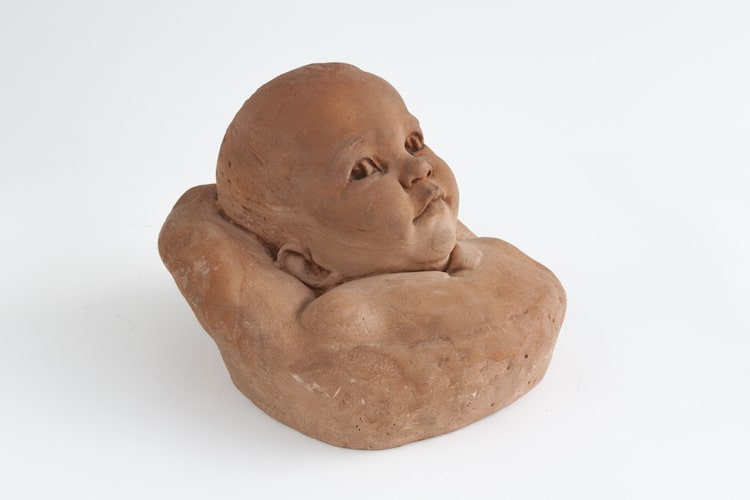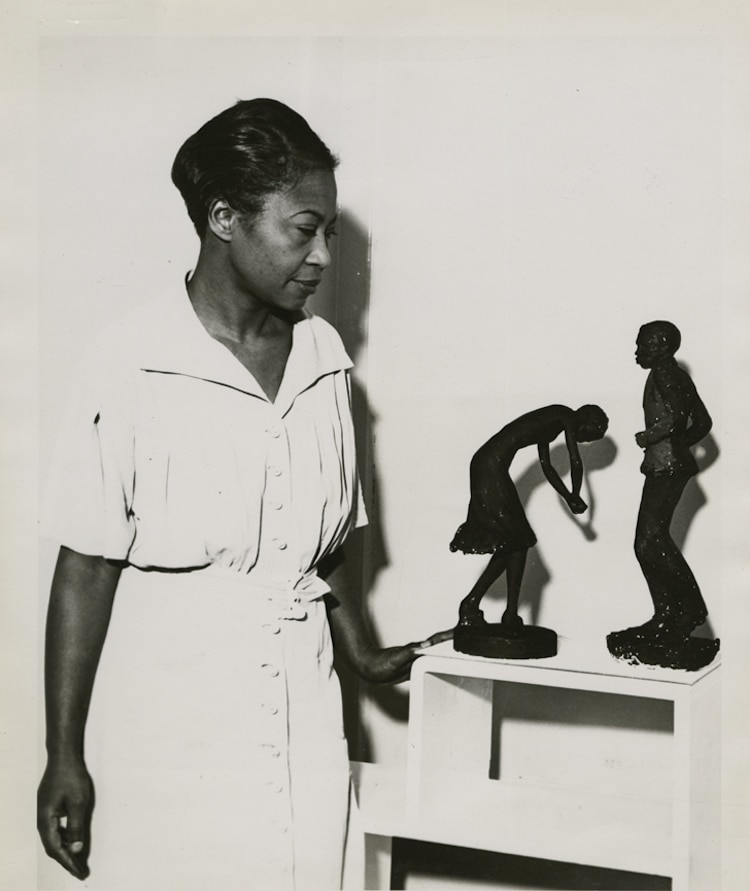
Andrew Herman (active 1930s–1940s), Federal Art Project, Works Progress Administration
Augusta Savage with her sculpture Realization, 1938 (Gelatin silver print, 10 x 8 in.
Schomburg Center for Research in Black Culture, NYPL, Photographs and Prints Division, Astor, Lenox and Tilden Foundations, 86-0036) (Photo: New York Historical Society [Public Domain])
As a teacher and advocate for African Americans in the arts, Savage shaped the careers of some of the Harlem Renaissance‘s most prominent artists. While she was a skilled ceramicist her in own right, Savage considered the impression she left on her students to be her true masterpiece. “I have created nothing really beautiful, really lasting, but if I can inspire one of these youngsters to develop the talent I know they possess, then my monument will be in their work,” she said.
Although this “monument” is at the heart of the Harlem Renaissance, many people are unaware of Savage's role in the groundbreaking movement. Here, we take a look at her life and work, from her humble beginnings in clay to her mold-breaking legacy.
A Career Takes Shape

Augusta Savage, “Portrait of a Baby,” 1942
(Terracotta, 10 x 8½ x 8 in.
Courtesy of Michael Rosenfeld Gallery LLC, New York, NY) (Photo: New York Historical Society [Public Domain])
In 1919, Savage solidified her role as an innovative sculptor when her work won an award for originality at a Florida fair. Two years later, she moved to New York City, where she applied to the Cooper Union for the Advancement of Science and Art, a progressive, scholarship-based university in Manhattan. Though up against 142 male applicants, Savage was accepted, and, in 1923, she earned her degree—an entire year early.
While Savage was rightly recognized for her talents at Cooper Union, her early career experiences were not without racism and sexism. In 1923, a committee rejected her application for a summer art program in France due to her race. Savage contested the decision to no avail. However, committee member and sculptor Hermon Atkins MacNeil championed Savage's work, eventually becoming her teacher.
That same year, Savage received her first big commission: a bust of civil rights activist and writer W. E. B. Du Bois for the Harlem Library. Though struggling financially, over the next few years, she was granted scholarships, won prizes, became an outspoken advocate against “negro primitive” art, and (thanks to donations) studied in Paris—all before making Harlem Renaissance history.
View this post on Instagram
In 1929, Savage created Gamin, a bust depicting a young African American boy, modeled after the artist’s own “little nephew.” He had come to live with Savage after his home in Florida was damaged by a hurricane. At the Schomburg Center for Research in Black Culture, curator Jeffreen M. Hayes found the following quotation from Savage in a 1935 interview with the Federal Art Commission: “I bought some materials, set a dry goods box on the living room table, stood my nephew alongside the table, and worked practically all night, till we were both exhausted.”
Made from plaster and covered in gold paint, Savage depicted the boy wearing a wrinkled shirt and a bebop cap. He has a somber look on his face, suggesting his awareness of his hardship and poverty, even though he’s still a child. Gamin marked a turning point in Savage's career as it was met with acclaim. In May 1929, the sculpture helped Savage win the first Rosenwald Fund fellowship ever awarded to a visual artist. And the president of the Rosenwald Fund, Edwin Embree, even ordered a cast of Gamin for himself.
“Golden Age”

Unidentified photographer,
Augusta Savage viewing two of her sculptures, Susie Q and Truckin, c. 1939 (Gelatin silver print, 10 x 8 in.
Schomburg Center for Research in Black Culture, NYPL, Photographs and Prints Division, Art & Artists-Prophet, Nancy-Stull, Henry, 92-0360 Box 6) (Photo: New York Historical Society [Public Domain])
In 1934, the sculptor opened the Savage Studio of Arts and Crafts. Set in a Harlem basement, this school offered painting, drawing, and sculpting classes to budding Black artists (African American painter Jacob Lawrence was one of many pupils who would later see success). The Savage Studio of Arts and Crafts later became the Harlem Community Art Center. Key to the Harlem Renaissance's artistic advancements, this multi-cultural establishment (funded through the Federal Art Project) would foster the development of 1,500 students.
In addition to teaching, Savage was dedicated to advocacy. In the studio's second year, she co-founded the Harlem Artists Guild with multidisciplinary artist Charles Alston and muralist Elba Lightfoot. Aiming to address the “cultural, economic, social, and professional problems” facing African American artists, the guild laid out three main goals in its constitution: to encourage young talent, to foster a relationship between artists and the public, and to improve artists’ standards of living and opportunities.
As the Harlem Renaissance dwindled (a race riot in 1935 and the Great Depression brought the “golden age” to an end), so did many of its neighborhood-based projects. The guild dissolved in 1941, and the Harlem Community Art Center closed the following year.
Later Work and Legacy

Portrait of Augusta Savage (Photo: Wikimedia Commons [Public Domain])
View this post on Instagram
Issues with funding would continue to hinder Savage's post-Renaissance artistic plans. In 1945, she left both the city and its art scene to settle in Saugerties, a small town in New York. Here, she shifted her focus from sculpting to writing, culminating in a collection of unpublished children’s stories and murder mysteries. Savage lived in Saugerties until she died in 1962.
At the time of her death, Savage's contributions to the Harlem Renaissance and to modernism as a whole were largely forgotten. But now, at a crucial point in history, Savage is finally starting to receive the recognition she deserves.
“We are in a moment where the canon is being challenged and expanded because of how history overlooks women and artists of color,” Jeffreen Hayes, the curator of the 2019 exhibition Augusta Savage: Renaissance Woman, said. “For many of us in the art world who have spent our careers researching, writing, and curating exhibitions about women and artists of color, these artists have always had a place in art, regardless of their social or racial identity. When thinking about Savage, her place has always been an artist who was a brilliant sculptor who used her art to forge a path for staying true to one's artistic passion.”
Exploring both Savage's self-described “monument” and her own striking sculptures, this exhibition revealed the artist for what she is: “one of America’s most influential 20th-century artists.”
This article has been edited and updated.
Related Articles:
6 Groundbreaking African American Artists to Celebrate This Black History Month
How the National Endowment for the Arts Has Advocated for Artistic Advancement for 50 Years
Norman Rockwell’s “The Problem We All Live With,” a Groundbreaking Civil Rights Painting
Striking Street Photos Capture the Vibrant Culture of Harlem in the 1970s






















































































